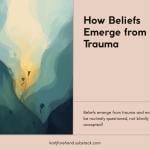
Mormonism is built on claims of historical events which make claims on us. A real resurrection of Jesus Christ, a real encounter between Joseph Smith, God the Father, and that same Jesus, a God who participates in real history. One result is that history has been the focus of many Mormons and students of Mormonism. History is a crucial part of Mormon identity; the shared narrative situates each person into God’s grand “plan of salvation.” Mormons are usually more sensitive to the ways the Mormon story is represented in popular history works. I’m thinking specifically of pop history. Not history of popular culture, but history produced ostensibly for the masses. Pop history is the McDonalds of academia. “Drive-through” history, “Big Mac” history; call it what you will, it’s the bane of good historians’ existence because it actually sells! It also helps shape popular perception of Mormonism.
A story I heard on NPR’s “All Things Considered” got me considering the topic again.1 They were discussing a new book called Lost States: True Stories of Texlahoma, Transylvania, and Other States That Never Made It by Michael J. Trinklein. I checked out the excerpts from the book on NPR’s website—lo and behold, the first example discussed was “Deseret.” Here’s the gist of the story in a frighteningly small nutshell:
After church founder Joseph Smith was killed, a large body of Mormons led by Brigham Young left Illinois to settle part of the largely unsettled space between the eastern states and California. Their proposal to create the state of Deseret was denied, a territory called “Utah” was established instead, problems occurred, decades later compromises regarding plural marriage were reached, Utah achieved statehood on a much smaller piece of real estate than what the original proposal included.
There’s obviously much more to this story and condensing into the soundbite formula is difficult. That being said, here’s the synopsis provided in Lost States. Warning: quirky, snappiness ahead:
The Mormon church was born in New York in the 1820s. So how did it end up in Utah? Almost from the beginning, the church’s unusual beliefs led to persecution, and members kept transplanting themselves to avoid harassment.
Things got especially messy when founder Joseph Smith received a revelation that he should start taking more wives. Lots more. Soon he was encouraging other Mormon men to do the same. This diminished the available supply of comely young women, which upset a lot of non-Mormon men, especially the bachelors. For this reasons [sic] — among others — an angry mob killed Smith in 1844.
This left master-organizer Brigham Young in charge. He solved the angry-bachelor problem by deciding to move the Mormons west to a place that had no white settlements. Thus began the Mormon exodus to the Salt Lake basin in the mid-1840s.2
Plural marriage played a role in the martyrdom of Joseph Smith, the problems in Nauvoo, and the exodus of the Mormons from Illinois. But this take seems ridiculous. “Comely young women” shortage? Any mention of the federal struggles and state’s rights, religious belief and the Constitution, etc.? Not here. And Trinklein wraps it up with this weird observation:
The state’s final size was much smaller than the Mormons had originally hoped. The entire western half of the Mormon empire was sliced off to form Nevada, establishing one of the oddest geographical juxtapositions in the United States. Could two states like Nevada and Utah be more different? Is it a joke that they are adjacent? In Utah, it’s really hard to get a drink. In Nevada, it’s really hard not to get a drink.3
I realize he’s probably aiming for a “lol” moment there and I haven’t read the whole book—perhaps it has better coverage of other almost-states. Still, when an author butchers something you are already well-familiar with, it doesn’t inspire confidence in the rest of their work. Selection in writing history can skew any story, but there are plenty of interesting things to be said about Utah’s struggle for statehood without such distortions. I’m not praising hyper-revisionist or excruciatingly boring sorts of history, to be sure. But clearly, engaging stories can be told more accurately than this. The premise of the book is interesting, but why so much creme filling?
This question is even more poignant for some of the up-and-coming historians interested in Mormonism. These souls find history meaningful enough to devote their careers to thinking about it. They carry the weight of academic training on their backs, which means the sort of history they find meaningful will be different than the popular fluffy stuff. They’ll be asking different questions and seeing things differently. Above all, they may wonder how to help fellow faithful Mormons better understand history when they’re already confronted with popular books they finds less-than-perfect. “My experience,” an up-an-comer named Ben writes, “is that academically trained historians, especially within the Mormon tradition, wish that the faithful masses had a better understanding of the history of the Church; we wish that they would leave back a lot of the “silly” folklore we hear in Sunday school. However, when we write, we often only write for fellow academics…”4
I’m not a professionally trained historian. I’m an amateur who tries to stay current with philosophy and methods of history, as well as the current state of Mormon history generally. But in the spirit of semi-elitist-navel-gazing I join Ben in asking some of those same questions. Certainly the tide of academic history on Mormonism seems to be rising, with projects like the Joseph Smith Papers and books like the recent Massacre at Mountain Meadows. I’ve heard this book in particular sold like gang-busters, which is encouraging. It demonstrates a rising hunger for serious engagement with the Mormon past that rises above self-congratulation or attack (or it will be another nice looking book for the non-coffee table or on bookshelf next to the scriptures). Nevertheless, it still seems that the catalog at Deseret Book is filled more with homiletic or devotional pieces (and candy and wooden signs for your wall!) than books like Massacre.
How can my favorite historians make their voices heard? I believe the “best books” Mormons are enjoined to search need not include the high-calorie fast food books, the sort of books theologian David Bentley Hart lamented:
Sadly, however, it is not serious historians who, for the most part, form the historical consciousness of their times; it is bad popular historians, generally speaking, and the historical hearsay they repeat or invent, and the myths they perpetuate and simplifications they promote, that tend to determine how most of us view the past. However assiduously the diligent, painstakingly precise academical drudge may labor at his or her meticulously researched and exhaustively documented tomes, nothing he or she produces will enjoy a fraction of the currency of any of the casually composed (though sometimes lavishly illustrated) squibs heaped on the front tables of chain bookstores or clinging to the middle rungs of best-seller lists….
After all, few have the time or the need to sift through academic journals and monographs and tedious disquisitions on abstruse topics trying to separate the gold from the dross. And so, naturally, among the broadly educated and the broadly uneducated alike, it is the simple picture that tends to prevail, though in varying shades and intensities of color, as with any image often and cheaply reproduced.5
If this is so, why? And how can it change?
FOOTNOTES
[1]
“Beyond 50: American States That Might Have Been,” All Things Considered, 2 April 2010.
[4]
Ben, “A Pillar of Light, The First Vision, and History for the Masses,” Juvenile Instructor, 29 May 2009.
[5]
David Bentley Hart, Atheist Delusions: The Christian Revolution and Its Fashionable Enemies, (Yale University Press, 2009), 35. See my review (or pop review?!) of this book here.











